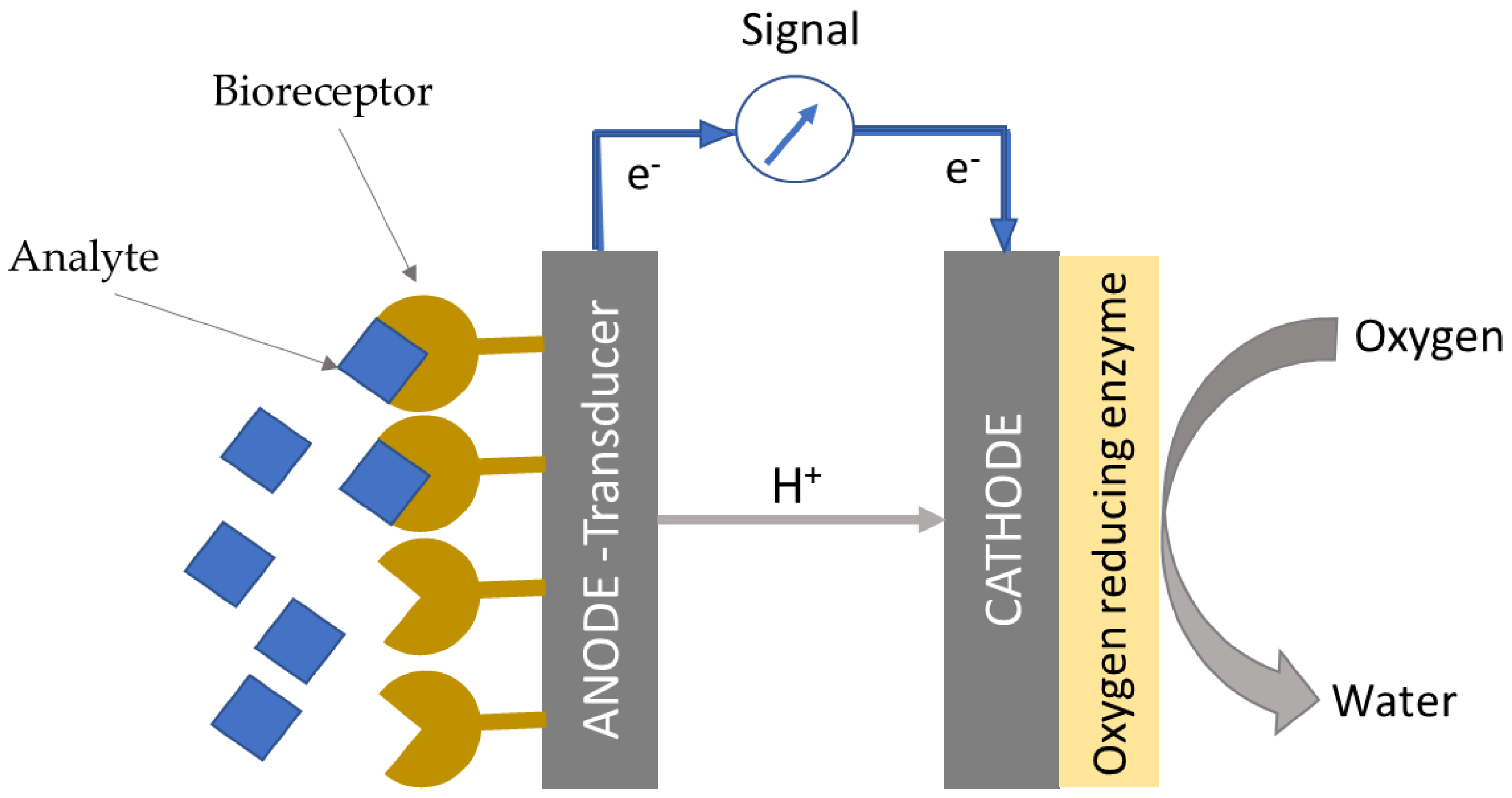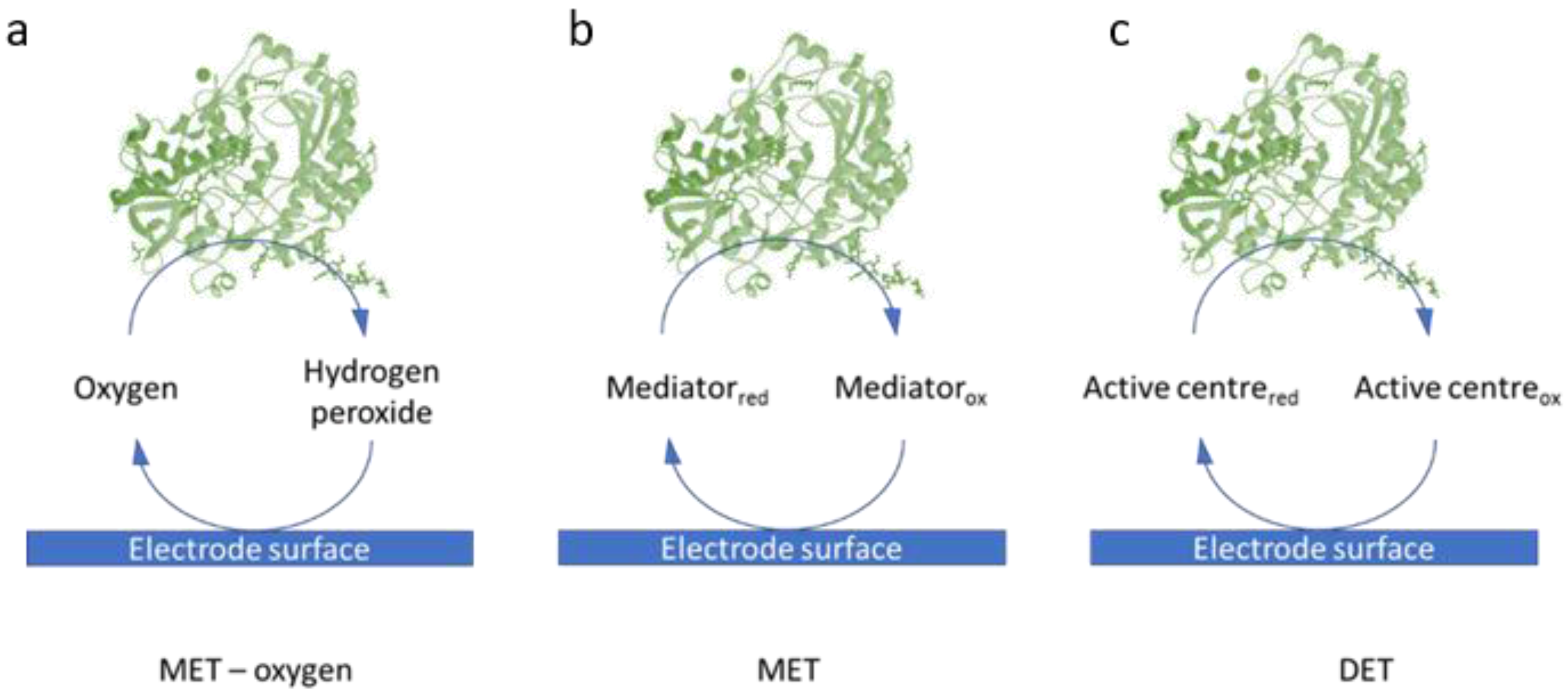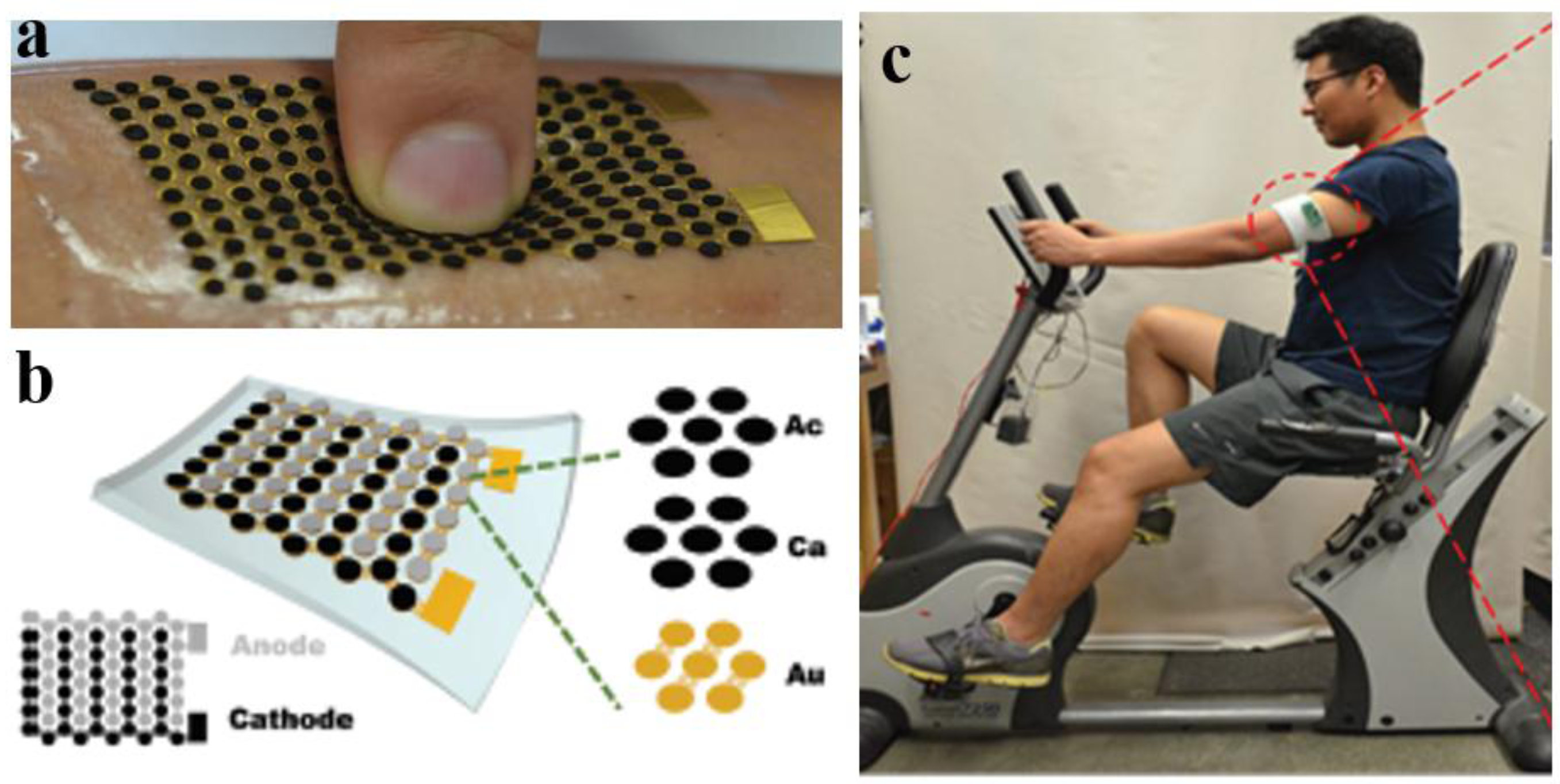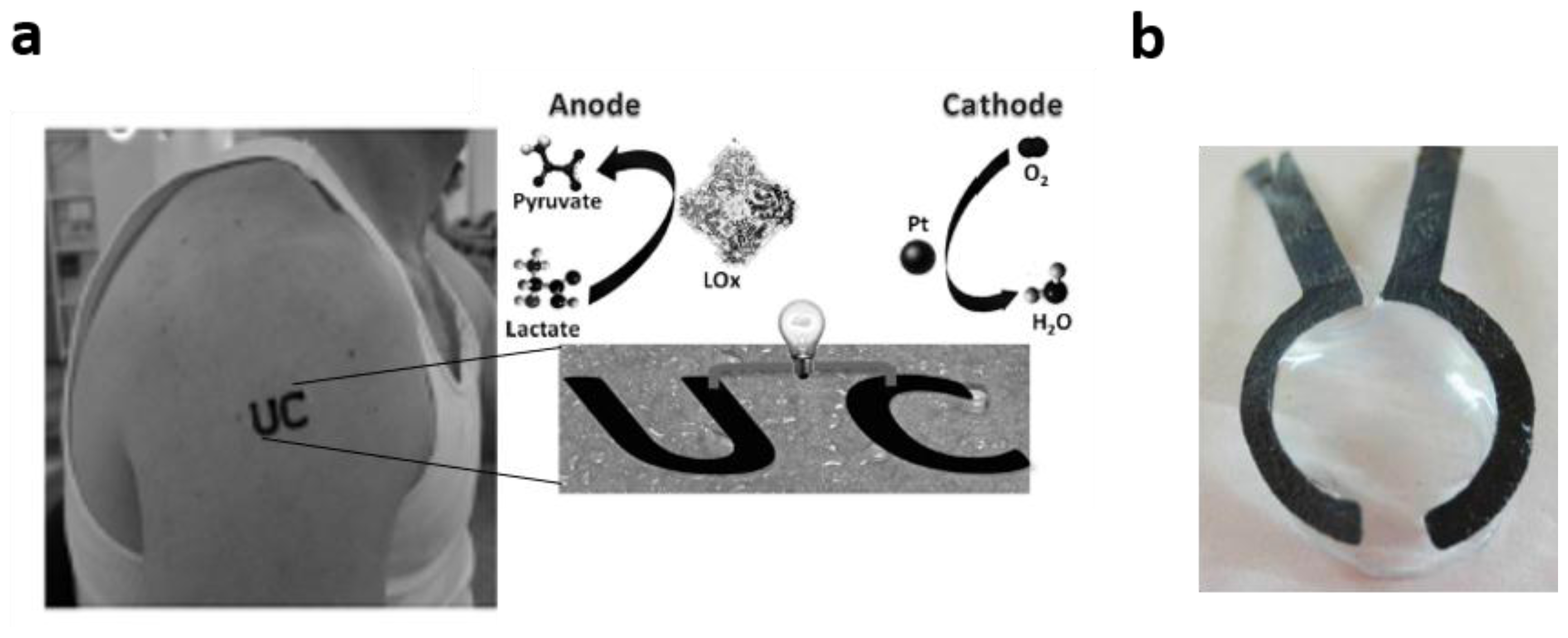Enzymatic Fuel Cells: Towards Self-Powered Implantable and Wearable Diagnostics
Abstract
:1. The Burden of Chronic Diseases
2. Enzymatic Fuel Cells for Biosensing Applications
3. Implantable Enzymatic Fuel Cells
4. Wearable Enzymatic Fuel Cells
5. Self-Powered Detection of Interesting Biomarkers with EFC-Based Sensors
5.1. Lactate
5.2. Cholesterol
5.3. Other Biomarkers
5.3.1. Metabolites
5.3.2. Neurotransmitters
5.3.3. Drugs
6. Conclusions and Further Perspectives
Acknowledgments
Author Contributions
Conflicts of Interest
References
- WHO. Global Status Report on Noncommunicable Diseases; WHO: Geneva, Switzerland, 2014. [Google Scholar]
- Office for National Statistics ONS. UK Health Accounts. 2015. Available online: http://bit.ly/2oIVPJb (accessed on 22 December 2017).
- Tudos, A.J.; Besselink, G.A.J.; Schasfoort, R.B.M. Trends in miniaturized total analysis systems for point-of-care testing in clinical chemistry. Lab Chip 2001, 1, 83–95. [Google Scholar] [CrossRef] [PubMed]
- Du Toit, H.; Rashidi, R.; Ferdani, D.W.; Delgado-Charro, M.B.; Sangan, C.M.; Di Lorenzo, M. Generating power from transdermal extracts using a multi-electrode miniature enzymatic fuel cell. Biosens. Bioelectron. 2016, 78, 411–417. [Google Scholar] [CrossRef] [PubMed] [Green Version]
- Rocchitta, G.; Spanu, A.; Babudieri, S.; Latte, G.; Madeddu, G.; Galleri, G.; Nuvoli, S.; Bagella, P.; Demartis, M.; Fiore, V.; et al. Enzyme biosensors for biomedical applications: Strategies for safeguarding analytical performances in biological fluids. Sensors 2016, 16, 780. [Google Scholar] [CrossRef] [PubMed]
- Bandodkar, A.J.; Wang, J. Non-invasive wearable electrochemical sensors: A review. Trends Biotechnol. 2014, 32, 363–371. [Google Scholar] [CrossRef] [PubMed]
- Barton, S.C.; Gallaway, J.; Atanassov, P. Enzymatic biofuel cells for implantable and microscale devices. Chem. Rev. 2004, 104, 4867–4886. [Google Scholar] [CrossRef] [PubMed]
- Page, C.C.; Moser, C.C.; Chen, X.; Dutton, P.L. Natural engineering principles of electron tunnelling in biological oxidation-reduction. Nature 1999, 402, 47–52. [Google Scholar] [CrossRef] [PubMed]
- Sakai, H.; Nakagawa, T.; Tokita, Y.; Hatazawa, T.; Ikeda, T.; Tsujimura, S.; Kano, K. A high-power glucose/oxygen biofuel cell operating under quiescent conditions. Energy Environ. Sci. 2009, 2, 133–138. [Google Scholar] [CrossRef]
- Sales, F.C.P.F.; Iost, R.M.; Martins, M.V.A.; Almeida, M.C.; Crespilho, F.N. An intravenous implantable glucose/dioxygen biofuel cell with modified flexible carbon fiber electrodes. Lab Chip 2013, 13, 468–474. [Google Scholar] [CrossRef] [PubMed]
- Reid, R.C.; Minteer, S.D.; Gale, B.K. Contact lens biofuel cell tested in a synthetic tear solution. Biosens. Bioelectron. 2015, 68, 142–148. [Google Scholar] [CrossRef] [PubMed]
- Moehlenbrock, M.J.; Minteer, S.D. Extended lifetime biofuel cells. Chem. Soc. Rev. 2008, 37, 1188–1196. [Google Scholar] [CrossRef] [PubMed]
- Halámková, L.; Halámek, J.; Bocharova, V.; Szczupak, A.; Alfonta, L.; Katz, E. Implanted biofuel cell operating in a living snail. J. Am. Chem. Soc. 2012, 134, 5040–5043. [Google Scholar] [CrossRef] [PubMed]
- Osadebe, I.; Conghaile, P.Ó.; Kavanagh, P.; Leech, D. Glucose oxidation by osmium redox polymer mediated enzyme electrodes operating at low potential and in oxygen, for application to enzymatic fuel cells. Electrochim.Acta 2015, 182, 320–326. [Google Scholar] [CrossRef]
- Hickey, D.P.; Milton, R.D.; Rasmussen, M.; Abdellaoui, S.; Nguyen, K.; Minteer, S.D. Fundamentals and applications of bioelectrocatalysis. Electrochemistry 2015, 13, 97. [Google Scholar] [CrossRef]
- Cracknell, J.A.; Vincent, K.A.; Armstrong, F.A. Enzymes as working or inspirational electrocatalysts for fuel cells and electrolysis. Chem. Rev. 2008, 108, 2439–2461. [Google Scholar] [CrossRef] [PubMed]
- Lee, I.; Loew, N.; Tsugawa, W.; Lin, C.-E.; Probst, D.; La Belle, J.T.; Sode, K. The electrochemical behavior of a fad dependent glucose dehydrogenase with direct electron transfer subunit by immobilization on self-assembled monolayers. Bioelectrochemistry 2018, 121, 1–6. [Google Scholar] [CrossRef] [PubMed]
- Ferri, S.; Kojima, K.; Sode, K. Review of glucose oxidases and glucose dehydrogenases: A bird’s eye view of glucose sensing enzymes. J. Diabetes Sci. Technol. 2011, 5, 1068–1076. [Google Scholar] [CrossRef] [PubMed]
- Milton, R.D.; Giroud, F.; Thumser, A.E.; Minteer, S.D.; Slade, R.C.T. Hydrogen peroxide produced by glucose oxidase affects the performance of laccase cathodes in glucose/oxygen fuel cells: Fad-dependent glucose dehydrogenase as a replacement. Phys. Chem. Chem. Phys. 2013, 15, 19371–19379. [Google Scholar] [CrossRef] [PubMed]
- Coman, V.; Ludwig, R.; Harreither, W.; Haltrich, D.; Gorton, L.; Ruzgas, T.; Shleev, S. A direct electron transfer-based glucose/oxygen biofuel cell operating in human serum. Fuel Cells 2010, 10, 9–16. [Google Scholar] [CrossRef]
- Ortiz, R.; Rahman, M.; Zangrilli, B.; Sygmund, C.; Micheelsen, P.O.; Silow, M.; Toscano, M.D.; Ludwig, R.; Gorton, L. Engineering of cellobiose dehydrogenases for improved glucose sensitivity and reduced maltose affinity. ChemElectroChem 2017, 4, 846–855. [Google Scholar] [CrossRef]
- Milton, R.D.; Lim, K.; Hickey, D.P.; Minteer, S.D. Employing fad-dependent glucose dehydrogenase within a glucose/oxygen enzymatic fuel cell operating in human serum. Bioelectrochemistry 2015, 106, 56–63. [Google Scholar] [CrossRef] [PubMed]
- Yoshida, H.; Sakai, G.; Mori, K.; Kojima, K.; Kamitori, S.; Sode, K. Structural analysis of fungus-derived fad glucose dehydrogenase. Sci. Rep. 2015, 5, 13498. [Google Scholar] [CrossRef] [PubMed]
- Ludwig, R.; Ortiz, R.; Schulz, C.; Harreither, W.; Sygmund, C.; Gorton, L. Cellobiose dehydrogenase modified electrodes: Advances by materials science and biochemical engineering. Anal. Bioanal. Chem. 2013, 405, 3637–3658. [Google Scholar] [CrossRef] [PubMed]
- Shim, J.; Kim, G.Y.; Moon, S.H. Covalent co-immobilization of glucose oxidase and ferrocenedicarboxylic acid for an enzymatic biofuel cell. J. Electroanal. Chem. 2011, 653, 14–20. [Google Scholar] [CrossRef]
- González-Guerrero, M.J.; del Campo, F.J.; Esquivel, J.P.; Leech, D.; Sabaté, N. Paper-based microfluidic biofuel cell operating under glucose concentrations within physiological range. Biosens. Bioelectron. 2017, 90, 475–480. [Google Scholar] [CrossRef] [PubMed]
- Hickey, D.P.; Reid, R.C.; Milton, R.D.; Minteer, S.D. A self-powered amperometric lactate biosensor based on lactate oxidase immobilized in dimethylferrocene-modified lpei. Biosens. Bioelectron. 2016, 77, 26–31. [Google Scholar] [CrossRef] [PubMed]
- Al-Lolage, F.A.; Meneghello, M.; Ma, S.; Ludwig, R.; Bartlett, P.N. A flexible method for the stable, covalent immobilization of enzymes at electrode surfaces. ChemElectroChem 2017, 4, 1528–1534. [Google Scholar] [CrossRef]
- Ruff, A.; Pinyou, P.; Nolten, M.; Conzuelo, F.; Schuhmann, W. A self-powered ethanol biosensor. ChemElectroChem 2017, 4, 890–897. [Google Scholar] [CrossRef]
- Du Toit, H.; Di Lorenzo, M. Glucose oxidase directly immobilized onto highly porous gold electrodes for sensing and fuel cell applications. Electrochim. Acta 2014, 138, 86–92. [Google Scholar] [CrossRef] [Green Version]
- Moreira, F.T.C.; Sale, M.G.F.; Di Lorenzo, M. Towards timely alzheimer diagnosis: A self-powered amperometric biosensor for the neurotransmitter acetylcholine. Biosens. Bioelectron. 2017, 87, 607–614. [Google Scholar] [CrossRef] [PubMed]
- Mazar, F.M.; Alijanianzadeh, M.; Molaeirad, A.; Heydari, P. Development of novel glucose oxidase immobilization on graphene/gold nanoparticles/poly neutral red modified electrode. Process Biochem. 2017, 56, 71–80. [Google Scholar] [CrossRef]
- Cho, E.; Mohammadifar, M.; Choi, S. A Self-Powered Sensor Patch for Glucose Monitoring in Sweat. In Proceedings of the 2017 IEEE 30th International Conference on Micro Electro Mechanical Systems (MEMS), Las Vegas, NV, USA, 22–26 January 2017; pp. 366–369. [Google Scholar]
- Kannan, P.; Chen, H.; Lee, V.T.-W.; Kim, D.-H. Highly sensitive amperometric detection of bilirubin using enzyme and gold nanoparticles on sol–gel film modified electrode. Talanta 2011, 86, 400–407. [Google Scholar] [CrossRef] [PubMed]
- Durand, F.; Gounel, S.; Kjaergaard, C.H.; Solomon, E.I.; Mano, N. Bilirubin oxidase from magnaporthe oryzae: An attractive new enzyme for biotechnological applications. Appl. Microbiol. Biotechnol. 2012, 96, 1489–1498. [Google Scholar] [CrossRef] [PubMed]
- Wang, T.; Milton, R.D.; Abdellaoui, S.; Hickey, D.P.; Minteer, S.D. Laccase inhibition by arsenite/arsenate: Determination of inhibition mechanism and preliminary application to a self-powered biosensor. Anal. Chem. 2016, 88, 3243–3248. [Google Scholar] [CrossRef] [PubMed]
- Wen, D.; Deng, L.; Guo, S.; Dong, S. Self-powered sensor for trace hg2+ detection. Anal. Chem. 2011, 83, 3968–3972. [Google Scholar] [CrossRef] [PubMed]
- Cinquin, P.; Gondran, C.; Giroud, F.; Mazabrard, S.; Pellissier, A.; Boucher, F.; Alcaraz, J.-P.; Gorgy, K.; Lenouvel, F.; Mathé, S.; et al. A glucose biofuel cell implanted in rats. PLoS ONE 2010, 5, e10476. [Google Scholar] [CrossRef] [PubMed]
- Zhao, C.-E.; Gai, P.; Song, R.; Chen, Y.; Zhang, J.; Zhu, J.-J. Nanostructured material-based biofuel cells: Recent advances and future prospects. Chem. Soc. Rev. 2017, 46, 1545–1564. [Google Scholar] [CrossRef] [PubMed]
- Liu, C.; Alwarappan, S.; Chen, Z.; Kong, X.; Li, C.-Z. Membraneless enzymatic biofuel cells based on graphene nanosheets. Biosens. Bioelectron. 2010, 25, 1829–1833. [Google Scholar] [CrossRef] [PubMed]
- Szczupak, A.; Halamek, J.; Halamkova, L.; Bocharova, V.; Alfonta, L.; Katz, E. Living battery—Biofuel cells operating in vivo in clams. Energy Environ. Sci. 2012, 5, 8891–8895. [Google Scholar] [CrossRef]
- MacVittie, K.; Halamek, J.; Halamkova, L.; Southcott, M.; Jemison, W.D.; Lobel, R.; Katz, E. From “cyborg” lobsters to a pacemaker powered by implantable biofuel cells. Energy Environ. Sci. 2013, 6, 81–86. [Google Scholar] [CrossRef]
- Hao Yu, E.; Scott, K. Enzymatic biofuel cells—Fabrication of enzyme electrodes. Energies 2010, 3, 23–42. [Google Scholar] [CrossRef]
- Cadet, M.; Gounel, S.; Stines-Chaumeil, C.; Brilland, X.; Rouhana, J.; Louerat, F.; Mano, N. An enzymatic glucose/o2 biofuel cell operating in human blood. Biosens. Bioelectron. 2016, 83, 60–67. [Google Scholar] [CrossRef] [PubMed]
- Pankratov, D.; Ohlsson, L.; Gudmundsson, P.; Halak, S.; Ljunggren, L.; Blum, Z.; Shleev, S. Ex vivo electric power generation in human blood using an enzymatic fuel cell in a vein replica. RSC Adv. 2016, 6, 70215–70220. [Google Scholar] [CrossRef]
- Onuki, Y.; Bhardwaj, U.; Papadimitrakopoulos, F.; Burgess, D.J. A review of the biocompatibility of implantable devices: Current challenges to overcome foreign body response. J. Diabetes Sci. Technol. 2008, 2, 1003–1015. [Google Scholar] [CrossRef] [PubMed]
- Kotanen, C.N.; Moussy, F.G.; Carrara, S.; Guiseppi-Elie, A. Implantable enzyme amperometric biosensors. Biosens. Bioelectron. 2012, 35, 14–26. [Google Scholar] [CrossRef] [PubMed]
- Rebelo, T.S.C.R.; Pereira, C.M.; Sales, M.G.F.; Noronha, J.P.; Costa-Rodrigues, J.; Silva, F.; Fernandes, M.H. Sarcosine oxidase composite screen-printed electrode for sarcosine determination in biological samples. Anal. Chim. Acta 2014, 850, 26–32. [Google Scholar] [CrossRef] [PubMed]
- Rasmussen, M.; Ritzmann, R.E.; Lee, I.; Pollack, A.J.; Scherson, D. An implantable biofuel cell for a live insect. J. Am. Chem. Soc. 2012, 134, 1458–1460. [Google Scholar] [CrossRef] [PubMed]
- Castorena-Gonzalez, J.A.; Foote, C.; MacVittie, K.; Halámek, J.; Halámková, L.; Martinez-Lemus, L.A.; Katz, E. Biofuel cell operating in vivo in rat. Electroanalysis 2013, 25, 1579–1584. [Google Scholar] [CrossRef]
- Kumar, S.; Padmashree, S.; Jayalekshmi, R. Correlation of salivary glucose, blood glucose and oral candidal carriage in the saliva of type 2 diabetics: A case-control study. Contempo. Clin. Dent. 2014, 5, 312–317. [Google Scholar] [CrossRef] [PubMed]
- Zhang, J.; Hodge, W.; Hutnick, C.; Wang, X. Noninvasive diagnostic devices for diabetes through measuring tear glucose. J. Diabetes Sci. Technol. 2011, 5, 166–172. [Google Scholar] [CrossRef] [PubMed]
- Falk, M.; Andoralov, V.; Blum, Z.; Sotres, J.; Suyatin, D.B.; Ruzgas, T.; Arnebrant, T.; Shleev, S. Biofuel cell as a power source for electronic contact lenses. Biosens. Bioelectron. 2012, 37, 38–45. [Google Scholar] [CrossRef] [PubMed]
- Jia, W.; Valdés-Ramírez, G.; Bandodkar, A.J.; Windmiller, J.R.; Wang, J. Epidermal biofuel cells: Energy harvesting from human perspiration. Angew. Chem. Int. Ed. 2013, 52, 7233–7236. [Google Scholar] [CrossRef] [PubMed]
- Bandodkar, A.J.; You, J.-M.; Kim, N.-H.; Gu, Y.; Kumar, R.; Mohan, A.M.V.; Kurniawan, J.; Imani, S.; Nakagawa, T.; Parish, B.; et al. Soft, stretchable, high power density electronic skin-based biofuel cells for scavenging energy from human sweat. Energy Environ. Sci. 2017, 10, 1581–1589. [Google Scholar] [CrossRef]
- Falk, M.; Pankratov, D.; Lindh, L.; Arnebrant, T.; Shleev, S. Miniature direct electron transfer based enzymatic fuel cell operating in human sweat and saliva. Fuel Cells 2014, 14, 1050–1056. [Google Scholar] [CrossRef]
- Escalona-Villalpando, R.A.; Reid, R.C.; Milton, R.D.; Arriaga, L.G.; Minteer, S.D.; Ledesma-García, J. Improving the performance of lactate/oxygen biofuel cells using a microfluidic design. J. Power Sour. 2017, 342, 546–552. [Google Scholar] [CrossRef]
- Gonzalez-Guerrero, M.J.; Esquivel, J.P.; Sanchez-Molas, D.; Godignon, P.; Munoz, F.X.; del Campo, F.J.; Giroud, F.; Minteer, S.D.; Sabate, N. Membraneless glucose/o2 microfluidic enzymatic biofuel cell using pyrolyzed photoresist film electrodes. Lab Chip 2013, 13, 2972–2979. [Google Scholar] [CrossRef] [PubMed]
- Du Toit, H.; Di Lorenzo, M. Continuous power generation from glucose with two different miniature flow-through enzymatic biofuel cells. Biosens. Bioelectron. 2015, 69, 199–205. [Google Scholar] [CrossRef] [PubMed] [Green Version]
- Pankratov, D.; Sundberg, R.; Sotres, J.; Maximov, I.; Graczyk, M.; Suyatin, D.B.; González-Arribas, E.; Lipkin, A.; Montelius, L.; Shleev, S. Transparent and flexible, nanostructured and mediatorless glucose/oxygen enzymatic fuel cells. J. Power Sour. 2015, 294, 501–506. [Google Scholar] [CrossRef]
- Moschou, D.; Tserepi, A. The lab-on-pcb approach: Tackling the μtas commercial upscaling bottleneck. Lab Chip 2017, 17, 1388–1405. [Google Scholar] [CrossRef] [PubMed]
- Wu, X.E.; Guo, Y.Z.; Chen, M.Y.; Chen, X.D. Fabrication of flexible and disposable enzymatic biofuel cells. Electrochim. Acta 2013, 98, 20–24. [Google Scholar] [CrossRef]
- López-Marzo, A.M.; Merkoçi, A. Based sensors and assays: A success of the engineering design and the convergence of knowledge areas. Lab Chip 2016, 16, 3150–3176. [Google Scholar] [CrossRef] [PubMed]
- Fischer, C.; Fraiwan, A.; Choi, S. A 3d paper-based enzymatic fuel cell for self-powered, low-cost glucose monitoring. Biosens. Bioelectron. 2016, 79, 193–197. [Google Scholar] [CrossRef] [PubMed]
- Chouler, J.; Cruz-Izquierdo, Á.; Rengaraj, S.; Scott, J.L.; Di Lorenzo, M. A screen-printed paper microbial fuel cell biosensor for detection of toxic compounds in water. Biosens. Bioelectron. 2018, 102, 49–56. [Google Scholar] [CrossRef] [PubMed]
- Zhou, M. Recent progress on the development of biofuel cells for self—Powered electrochemical biosensing and logic biosensing: A review. Electroanalysis 2015, 27, 1786–1810. [Google Scholar] [CrossRef]
- Sekretaryova, A.N.; Beni, V.; Eriksson, M.; Karyakin, A.A.; Turner, A.P.F.; Vagin, M.Y. Cholesterol self-powered biosensor. Anal. Chem. 2014, 86, 9540–9547. [Google Scholar] [CrossRef] [PubMed]
- Amorini, A.M.; Nociti, V.; Petzold, A.; Gasperini, C.; Quartuccio, E.; Lazzarino, G.; Di Pietro, V.; Belli, A.; Signoretti, S.; Vagnozzi, R.; et al. Serum lactate as a novel potential biomarker in multiple sclerosis. Biochim. Biophys. Acta 2014, 1137–1143. [Google Scholar] [CrossRef] [PubMed]
- Sakharov, D.A.; Shkurnikov, M.U.; Vagin, M.Y.; Yashina, E.I.; Karyakin, A.A.; Tonevitsky, A.G. Relationship between lactate concentrations in active muscle sweat and whole blood. Bull. Exp. Biol. Med. 2010, 150, 83–85. [Google Scholar] [CrossRef] [PubMed]
- Malon, R.S.; Sadir, S.; Balakrishnan, M.; Córcoles, E.P. Saliva-based biosensors: Noninvasive monitoring tool for clinical diagnostics. BioMed Res. Int. 2014. [Google Scholar] [CrossRef] [PubMed]
- Van Haeringen, N.J.; Glasius, E. Collection method dependant concentrations of some metabolites in human tear fluid, with special reference to glucose in hyperglycaemic conditions. Albrecht Graefes Arch. Klin. Exp. Ophthalmol. 1977, 202, 1–7. [Google Scholar] [CrossRef]
- De Backer, G.; Ambrosioni, E.; Borch-Johnsen, K.; Brotons, C.; Cifkova, R.; Dallongeville, J.; Ebrahim, S.; Faergeman, O.; Graham, I.; Mancia, G.; et al. European guidelines on cardiovascular disease prevention in clinical practicethird joint task force of european and other societies on cardiovascular disease prevention in clinical practice (constituted by representatives of eight societies and by invited experts). Eur. Heart J. 2003, 24, 1601–1610. [Google Scholar] [PubMed]
- Félix-Redondo, F.J.; Grau, M.; Fernández-Bergés, D. Cholesterol and cardiovascular disease in the elderly. Facts Gaps Aging Dis. 2013, 4, 154–169. [Google Scholar]
- Quah, T.; Abdellaoui, S.; Milton, R.D.; Hickey, D.P.; Minteer, S.D. Cholesterol as a promising alternative energy source: Bioelectrocatalytic oxidation using nad-dependent cholesterol dehydrogenase in human serum. J. Electrochem. Soc. 2017, 164, H3024–H3029. [Google Scholar] [CrossRef]
- Laffel, L. Ketone bodies: A review of physiology, pathophysiology and application of monitoring to diabetes. Diabetes/Metab. Res. Rev. 1999, 15, 412–426. [Google Scholar]
- Weber, C.; Kocher, S.; Neeser, K.; Joshi, S.R. Prevention of diabetic ketoacidosis and self-monitoring of ketone bodies: An overview. Curr. Med. Res. Opin. 2009, 25, 1197–1207. [Google Scholar] [CrossRef] [PubMed]
- Martínez-García, G.; Pérez-Julián, E.; Agüí, L.; Cabré, N.; Joven, J.; Yáñez-Sedeño, P.; Pingarrón, J.M. An electrochemical enzyme biosensor for 3-hydroxybutyrate detection using screen-printed electrodes modified by reduced graphene oxide and thionine. Biosensors 2017, 7, 50. [Google Scholar] [CrossRef] [PubMed]
- Soukup, M.; Biesiada, I.; Henderson, A.; Idowu, B.; Rodeback, D.; Ridpath, L.; Bridges, E.G.; Nazar, A.M.; Bridges, K.G. Salivary uric acid as a noninvasive biomarker of metabolic syndrome. Diabetol. Metab. Syndr. 2012, 4, 14. [Google Scholar] [CrossRef] [PubMed]
- Labib, M.; Sargent, E.H.; Kelley, S.O. Electrochemical methods for the analysis of clinically relevant biomolecules. Chem. Rev. 2016, 116, 9001–9090. [Google Scholar] [CrossRef] [PubMed]
- Kim, J.; Imani, S.; de Araujo, W.R.; Warchall, J.; Valdés-Ramírez, G.; Paixão, T.R.L.C.; Mercier, P.P.; Wang, J. Wearable salivary uric acid mouthguard biosensor with integrated wireless electronics. Biosens. Bioelectron. 2015, 74, 1061–1068. [Google Scholar] [CrossRef] [PubMed]
- Lasisi, T.J.; Raji, Y.R.; Salako, B.L. Salivary creatinine and urea analysis in patients with chronic kidney disease: A case control study. BMC Nephrol. 2016, 17, 10. [Google Scholar] [CrossRef] [PubMed]
- Venkatapathy, R.; Govindarajan, V.; Oza, N.; Parameswaran, S.; Pennagaram Dhanasekaran, B.; Prashad, K.V. Salivary creatinine estimation as an alternative to serum creatinine in chronic kidney disease patients. Int. J. Nephrol. 2014, 742724. [Google Scholar] [CrossRef] [PubMed]
- Chen, P.; Peng, Y.; He, M.; Yan, X.-C.; Zhang, Y.; Liu, Y.-N. Sensitive electrochemical detection of creatinine at disposable screen-printed carbon electrode mixed with ferrocenemethanol. Int. J. Electrochem. Sci. 2013, 8, 8931–8939. [Google Scholar]
- Sreekumar, A.; Poisson, L.M.; Rajendiran, T.M.; Khan, A.P.; Cao, Q.; Yu, J.; Laxman, B.; Mehra, R.; Lonigro, R.J.; Li, Y.; et al. Metabolomic profiles delineate potential role for sarcosine in prostate cancer progression. Nature 2009, 457, 910–914. [Google Scholar] [CrossRef] [PubMed]
- Cernei, N.; Heger, Z.; Gumulec, J.; Zitka, O.; Masarik, M.; Babula, P.; Eckschlager, T.; Stiborova, M.; Kizek, R.; Adam, V. Sarcosine as a potential prostate cancer biomarker—A review. Int. J. Mol. Sci. 2013, 14, 13893–13908. [Google Scholar] [CrossRef] [PubMed]
- Cernei, N.; Zitka, O.; Ryvolova, M.; Adam, V.; Masarik, M.; Hubalek, J.; Kizek, R. Spectrometric and electrochemical analysis of sarcosine as a potential prostate carcinoma marker. Int. J. Electrochem. Sci. 2012, 7, 4286–4301. [Google Scholar]
- Wu, F.; Yu, P.; Mao, L. Self-powered electrochemical systems as neurochemical sensors: Toward self-triggered in vivo analysis of brain chemistry. Chem. Soc. Rev. 2017, 46, 2692–2704. [Google Scholar] [CrossRef] [PubMed]
- Streffer, K.; Vijgenboom, E.; Tepper, A.W.J.W.; Makower, A.; Scheller, F.W.; Canters, G.W.; Wollenberger, U. Determination of phenolic compounds using recombinant tyrosinase from streptomyces antibioticus. Anal. Chim. Acta 2001, 427, 201–210. [Google Scholar] [CrossRef]
- Kim, J.; Jeerapan, I.; Imani, S.; Cho, T.N.; Bandodkar, A.; Cinti, S.; Mercier, P.P.; Wang, J. Noninvasive alcohol monitoring using a wearable tattoo-based iontophoretic-biosensing system. ACS Sens. 2016, 1, 1011–1019. [Google Scholar] [CrossRef]






| Enzyme | Cofactor | Electron Transfer Mechanism | Substrate | Reference |
|---|---|---|---|---|
| Glucose oxidase (GOx) | FAD | MET | Glucose | [25] |
| Glucose dehydrogenase (NAD-GDH) | NAD | MET | Glucose | [26] |
| Glucose dehydrogenase (PQQ-GDH | PQQ | MET | Glucose | [13] |
| Glucose dehydrogenase (FAD-GDH) | FAD | DET | Glucose | [17] |
| Lactate oxidase (LOx) | FAD | MET | Lactate | [27] |
| Lactate dehydrogenase (LDH) | NAD | MET | Lactate | [11] |
| Cellobiose dehydrogenase (CDH) | Haem | DET | Glucose | [28] |
| Alcohol dehydrogenase (ADH) | NAD | MET | Alcohol | [29] |
| Anode | Mediator | Cathode | Implantation Place | Power Density | OCV (V) | Reference |
|---|---|---|---|---|---|---|
| Graphite discs containing glucose oxidase, ubiquinone and catalase | Ubiquinone | Graphite modified with polyphenol oxidase and quinone, surrounded by a cellulose dialysis membrane | Retroperitoneal space in rats | 6.5 µW | 0.275 | [38] |
| Buckypaper modified with PBSE and glucose dehydrogenase | PQQ | Buckypaper modified with PBSE and laccase | Snail hemocoel | 30 µW·cm−2 | n/a | [13] |
| FCF microelectrodes modified with neutral red and glucose oxidase crosslinked with glutaraldehyde | Neutral red | FCF modified with PAMAM-G4 dendrimer and PtNPs | Intravenous in a rat | 95 µW·cm−2 | 0.125 | [10] |
| Buckypaper modified with PBSE and glucose dehydrogenase | PQQ | Buckypaper modified with PBSE and laccase | Clams visceral mass | 40 µW·cm−2 | 0.3–0.4 | [41] |
| Carbon rod modified with osmium polymers and glucose oxidase crosslinked with PEGDGE | Osmium polymers | Bilirubin oxidase crosslinked with osmium polymers using PEGDGE and grafted onto carbon rods | Cockroachabdomen | 55 µW·cm−2 | n/a | [49] |
| Buckypaper modified with PBSE and glucose dehydrogenase | PQQ | Buckypaper modified with PBSE and laccase | Cremaster tissue in a rat | 0.175 µW·cm−2 | 0.140 | [50] |
| Carbon fibre modified with glucose dehydrogenase crosslinked with osmium polymers | Osmium polymers | Carbon fibre modified with bilirubin oxidase crosslinked with osmium polymers | In vitro with human blood | 68.1 µW cm−2 | 0.65 | [44] |
| Cellobiose dehydrogenase adsorbed onto graphite electrode | DET | Bilirubin oxidase adsorbed onto graphite electrode | Ex vivo with human blood | 0.74 µW | 0.31 | [45] |
| Biocatalysts (Anode/Cathode) | Material | Biomarker/Fuel | Biofluid | OCP (V) | Power Output (µW cm−2) | Reference |
|---|---|---|---|---|---|---|
| CDH/bilirubin oxidase | Gold wires attached to a contact lens | Glucose | Tears | 0.57 | 1 | [53] |
| Lactate oxidase/laccase | Toray carbon paper | Lactate | Tears | 0.64 ± 0.03 | 61.2 ± 9.2 | [57] |
| LDh-NAD/bilirubin oxidase | Buckypaper | Lactate | Tears | 0.413 ± 0.06 | 8.01 ± 1.4 | [11] |
| LOx/Ag2O nanoparticles | Screen printed in strecthable polymer | Lactate | Sweat | n/a | 1000 | [55] |
| Gox/activated carbon | Filter paper modified with PEDOT:PSS | Glucose | Sweat | n/a | n/a | [33] |
| Lactate oxidase/carbon ink modified with platinum black | Screen printed tattoo | Lactate | Sweat | n/a | 25 | [54] |
| Biomarker/Analyte | Enzymes | Application/Condition | Biofluid | Type of Sensor |
|---|---|---|---|---|
| Metabolites | ||||
| Glucose | Gox/GDH/CDH | Diabetes | Blood, saliva, sweat | Wearable |
| Lactate | LOx/LDH | Hypoxia | Blood, saliva, sweat | Wearable |
| Cholesterol | ChOx/ChDH | Atherosclerosis/heart failure | Blood | Implantable |
| Ketone bodies | 3-HBDH | Diabetes | Blood | Implantable |
| Uric acid | Uricase | Renal syndrome | Blood, saliva | Wearable |
| Creatinine | SOx | Chronic kidney disease | Blood, saliva | Wearable |
| Sarcosine | SOx | Prostate Cancer | Blood, urine | Implantable |
| Bilirubin | BOx | Jaundice/Kernicterus | Blood | Implantable |
| Neurotransmitters | ||||
| Glutamate | GlOx | Neurodegenerative diseases | Brain | Implantable |
| Acetylcholine | AChE-Choline oxidase | Neurodegenerative diseases | Blood | Implantable |
| Other analytes | ||||
| Levodopa | Tyrosinase | Parkinson treatment | Blood | Implantable |
| Alcohol | ADH/AOx | Alcohol abuse | Blood | Wearable |
© 2018 by the authors. Licensee MDPI, Basel, Switzerland. This article is an open access article distributed under the terms and conditions of the Creative Commons Attribution (CC BY) license (http://creativecommons.org/licenses/by/4.0/).
Share and Cite
Gonzalez-Solino, C.; Lorenzo, M.D. Enzymatic Fuel Cells: Towards Self-Powered Implantable and Wearable Diagnostics. Biosensors 2018, 8, 11. https://doi.org/10.3390/bios8010011
Gonzalez-Solino C, Lorenzo MD. Enzymatic Fuel Cells: Towards Self-Powered Implantable and Wearable Diagnostics. Biosensors. 2018; 8(1):11. https://doi.org/10.3390/bios8010011
Chicago/Turabian StyleGonzalez-Solino, Carla, and Mirella Di Lorenzo. 2018. "Enzymatic Fuel Cells: Towards Self-Powered Implantable and Wearable Diagnostics" Biosensors 8, no. 1: 11. https://doi.org/10.3390/bios8010011




